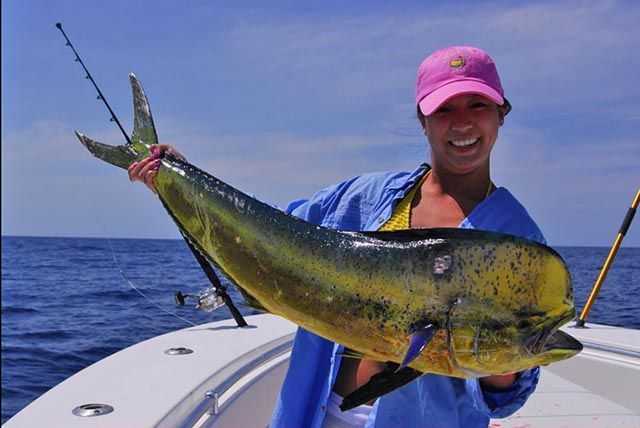
[dropcap]2[/dropcap]015 is here and so are the sails, dolphin, blackfin tuna and wahoo. With every cold front this month the offshore scene will heat up as water temperatures drop. For the first time in years there is bait scattered up and down the coast, and stacked up on reefs and wrecks. There’s no way fish are going to migrate past us this year without stopping and camping out for a while. Focus on current rips, color changes, and weed lines on the surface and concentrate on areas that are holding bait. Typical depths you want to fish are 115 to 175 feet of water, but after a few days of northwest or any west wind for that matter, don’t be scared to venture out to the deep. A lot of the time during a west wind fish and water conditions will push offshore.
Both live and dead bait work well this time of year, but unless you call an order in to the Goggle Guys, you might be trying to catch it for a while. Even when planning on live baiting for the day, it’s a good idea to bring a cooler with some ballyhoo rigged, along with a small dredge teaser in case you can’t find the bait, or something happens to your live well. Try rigging your ballyhoo on copper wire attached to a swivel, which will be used to connect it to the hook. A small chain lead will keep the bait upright and swimming well. Rather than fishing your rods locked up, or at strike, try backing the drag way off so there is just enough tension to keep the bait from slipping back. When a fish bites, put the reel in total free-spool and let the fish eat the bait for a few seconds. Push the level up and slowly start to reel. With circle hooks, there is no need to strike the fish or set hook. The main thing is free-spool as soon as you get the bite and when you push the drag up, there is no rush to reel or strike the fish. It seems like with circle hooks, the slower the better. Dredge teasers are still the difference between having a good day and having a phenomenal day this time of year. Whether live baiting or pulling dead baits, take the time to rig and pull a dredge. Mylar strip teasers work well, as do rubber fish teasers while live baiting. When pulling dead baits, I would recommend naturals, rubber shads, or a combination of the two. Be aware that the more rubber fish with knobby tails you put on, the more lead you will need in front of the teaser to keep it in the water. We pull all of our dredges off Cannon 10 TS downriggers. They are fully automatic and take the headaches and tangles out of pulling dredges.
Happy New Year! And I hope 2015 and your next fishing trip is Off the Chain.
Like our Face Book page S.P.F. Fishing Charters to keep up with the daily fishing reports and to check out various ‘How To’ videos.